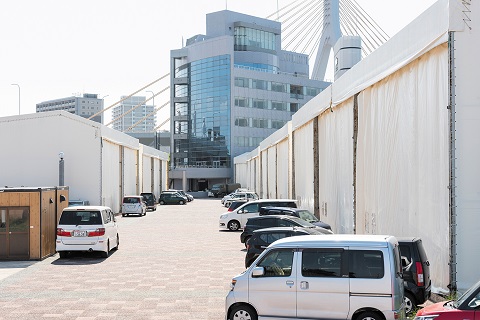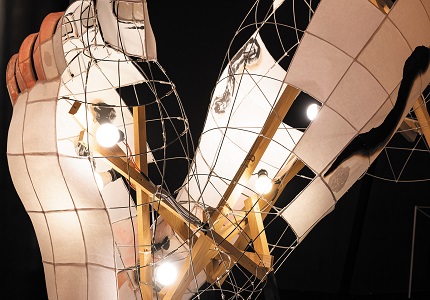
Paper and Light as Three-Dimensional Art
Aomori Nebuta
The Aomori Nebuta Matsuri is one of the three grand festivals of the Tohoku region in northeast Japan. The stars of this festival are the nebuta floats, which are giant paper lanterns in human forms whose appearance thrills the crowd. Massive three-dimensional artworks of paper and light, these floats are becoming more popular outside Japan today. The play of light passing through the bold colors of the washi paper, which is shaped into complex and beautiful curves with wire, is delicate and delightful. These beguiling nebuta speak to the single-minded passion of the people in northeast Japan for preserving their local culture.

Hiroo Takenami
Nebuta Artist
Born in 1959 in Kidzukuri-machi, Nishitsugaru-gun (now Tsugaru City), Aomori Prefecture. Graduated from Tohoku Pharmaceutical University (now Tohoku Medical and Pharmaceutical University). Presented his first large-scale nebuta in 1989. Since then, Takenami has created new works each year and has become a renowned nebuta-shi (creative director of nebuta production), winning the Nebuta Grand Prize, the 30th NHK Tohoku Culture Award, and numerous other awards. In 2010, he established Takenami Hiroo Nebuta Lab for creating and studying nebuta, as well as providing information and fostering the next generation of nebuta artisans. He continues to explore potential new modes of expression using nebuta.
Takenami Hiroo Nebuta Lab website
Takenami-nebuken.com

Although the theories on the origins of the Aomori Nebuta Matsuri festival are many and varied, the leading theory is that it developed from the tradition of floating lanterns to send off the spirits of the dead from the Tanabata festival, which came to Japan from China during the Nara period. It is believed that customs handed down over many generations in the Tsugaru region and events such as sending off the spirits of the dead, effigies used to ward off misfortune, and torch processions to drive away crop-eating insects were incorporated into the Tanabata festival and then morphed into the lanterns known as nebuta.
Source: Official Aomori Nebuta Matsuri website (www.nebuta.or.jp)
Seeing nebuta as works of art helps ensure the culture endures
The Aomori Nebuta Matsuri is held annually in August in Aomori City, Aomori Prefecture. The festival is widely recognized, both in and outside of Japan, as one of the most famous events representing Tohoku, even Japan as a whole. With more than 2.5 million visitors attending each year, the entire city is swept up in the excitement of the festival. The highlight of the Aomori Nebuta Matsuri is the parade of floats decorated with giant paper lantern figures. The floats, called nebuta, are massive, standing some five meters tall and nine meters wide. The human figures, three-dimensional depictions of warriors in rich bold colors outlined in powerful black lines, seem to float through the dark night. Swaggering as if alive, the nebuta are a striking and irresistibly alluring sight.
①-③ Nebuta floats from the 2018 Aomori Nebuta Matsuri.
Nebuta ① and ② created by Takenami; nebuta ③ created by Shigeki Tezuka, Takenami’s disciple.

- 拡大
- ① Iwakigawa Ryuou and Takeda Sadakiyo (by Aomori Hishiyu-kai), winner of the festival’s highest accolade, the Nebuta Grand Prize.

- 拡大
- ② Fujin Raijin (“Wind God and Thunder God”; JR Nebuta Executive Project).

- 拡大
- ③ Oounabara no Kami Konpira Daigongen (“The Great Sea God”; Maruhanichiro Nebuta-kai).
As the sweet smell of May fills the air, rows of large white tents appear in Aoiumi Park facing Mutsu Bay, and the residents of Aomori City start to get excited. The group of large sheds where the 22 giant nebuta, the stars of the Aomori Nebuta Festival, are crafted is referred to as Nebuta Rasseland. The name comes from the shouts of “Rassera, rassera!” from the nebuta dancers during the parade. These sheds are a hive of activity as production crews scramble to create their floats.
"The nebuta take a year to make," declares Hiroo Takenami, a nebuta-shi who has created massive nebuta every year for the past 30 years or so. "Most people think that the process begins when the sheds go up, but for us, this is the final stage in completing the nebuta. All year, I am going over several different plans in my mind, and by the beginning of autumn, we are working on the drawings for the piece we will put out next year." The nebuta may be displayed on the streets for just six days during the festival, but each takes a year to complete, from planning the theme to building the frame, installing the electrical wiring, papering, and painting. All of this work requires extraordinary dedication on the part of the people involved.
There are about 40 people on the production team for one large nebuta, which is led by an artist called a nebuta-shi who is the creative force behind the process. The team’s skilled experts take turns through the different stages of production — carpenters build the supports with structural lumber, electricians install some 1,000 light bulbs and fluorescent lights inside the structure, and others apply the paper to the completed frame. “But not everyone on the staff makes their living at nebuta. Most volunteer on the team while working day jobs. The nebuta are produced from sketches, and there are no structural drawings, but we have worked together for so long that it is easy for everyone to understand the artist’s image. Some on the team have an artistic bent and want to someday create large nebuta of their own. So we consult with each other as we go through a process of trial and error to create works that are even more exciting."

④Working on nebuta for the 2019 festival.

⑥Nebuta Rasseland, where the giant nebuta are created. Between July 1 and August 6, tours of the sheds with guide commentary are available.

⑤Working on nebuta for the 2019 festival.
Even Takenami was not always able to make a living only in nebuta and had to take on other work to make ends meet. "My hometown of Tsugaru had a culture of nebuta, too, and I grew up watching them being made. I started helping out when I was in third grade in elementary school, and I knew that I wanted some day to make these giant Aomori nebuta. But through my junior high and high school years, I came to see just how hard it is to make a profession of it. Thinking about the future, I studied to become a pharmacist, but even after getting a job, I spent my time after work and on the weekends training under a master nebuta-shi. I was thrilled when my hard work was recognized and I was able to present my own large nebuta just before I turned 30. Since I had achieved my childhood dream, I did think about going back to the security of a profession. However, creating nebuta just felt more “me” than being a pharmacist. So at 35, I committed myself wholeheartedly. In the beginning, I still worked twice a week as a part-time pharmacist to make ends meet, but gradually I shifted to focusing only on creating nebuta. Thanks to the support of so many people, I am now able to make a living from nebuta alone."

⑦Takenami nebuta featured in the Nisei Week parade held in Los Angeles, CA.

⑧ Somataro Yoshikado Yojutsu wo Kazaru (“Somataro Yoshikado Uses Sorcery”), a Takenami objet d’art exhibited at the Japanese Harmony of Light and Color Festival at Hotel Gajoen Tokyo.
The Aomori Nebuta Matsuri was featured at the Japan World Exposition held in Osaka in 1970, and the festival took part in every Festivals of Japan event held at Meijijingu Gaien in Tokyo from 1971 to 1984. With this exposure, people across Japan suddenly discovered the festival. Despite its designation as an Important Intangible Folk Cultural Property in 1980 and the fact that it has grown into a major festival that represents Japan in general, Takenami worries about the future. “There are a lot of young people who want to create large nebuta like I did when I was a kid.

⑨The studio set up as a space for young artists to be creative.

⑩Mentored by Takenami, Shigeki Tezuka debuted as a nebuta-shi in 2014.

- 拡大
- White nebuta before being painted. When lit in this state, the lines of the wire framework are illuminated, casting uniquely beautiful shadows.
However these days it is even more difficult to make a living at it. I worry that the nebuta themselves could disappear if we don’t have an environment that welcomes these young people and nurtures their talent. I think it is crucial that we create an economic environment that values these artistic expressions more so that the nebuta culture will be passed on to future generations. For these reasons, too, I hope to help make it possible to make a living as an artist who applies the nebuta techniques to other forms, not only to nebuta for these festivals.” Takenami opened the Takenami Hiroo Nebuta Lab in 2010. With the lab providing a studio for young people to be creative and expand opportunities for creating and presenting artwork through corporate collaboration, he continues to focus on nurturing successive generations in the world of nebuta.
One potential new mode of nebuta expression that Takenami is focused on is white nebuta left unpainted. At Kyoto University of Art and Design, they run a group workshop on producing Kyodzukuri Nebuta, sculpted pieces in white paper created with nebuta techniques. This is a basic skills program for all freshmen students at the university, and Takenami serves as the advisor, helping students create their own work. “I keep at this, because I enjoy seeing the work that the students create more than even the teaching. They present frame art made with traditional nebuta techniques and completely white three-dimensional figures that are neither paper lanterns nor lanterns that create shadows cast by light. By recognizing these pieces as works of art, I think we can develop the genre in new ways.
“Thanks to this university program, students who are fascinated by nebuta have, believe it or not, found work at companies in Aomori and come to me to learn nebuta techniques. They dove into the world of nebuta, not for the folk aspect, but as a gateway into the fascinating work of plastic arts. I hope to raise nebuta to works of art by welcoming young artists like these.” Takenami’s open-mindedness makes it possible to combine traditional techniques unique to nebuta with new sensibilities free of rigid conventional thinking. There is no end to the challenge he has taken on.
“There are three fundamental elements of the nebuta tradition that must be satisfied. There must be light coming from inside the figure. There must be a feeling of movement, but the nebuta figure itself cannot move. And finally, it must be made of paper.” Hoshoshi, a traditional high-quality kozo paper also used for official documents and ukiyo-e prints, was typically used for nebuta in the past. “I used to use Shikoku and Echizen hoshoshi paper myself, but I’ve since switched to rolls of shoji (a type of washi paper) made for businesses. Hoshoshi is perfect, because it takes the black ink well and makes for glossy color, but unfortunately it is vulnerable to water. At past festivals, we have ended up in sudden downpours of rain for several minutes, and the hoshoshi paper became pulpy and fell apart. For durability, we had no choice but to switch from hoshoshi to shoji paper.” Nebuta have changed in other ways, as well. The frames traditionally made of bamboo are now made of wire, and incandescent, fluorescent, and LED light bulbs have replaced the candles that once provided the interior light. As Takenami puts it, “Nebuta evolve with the times.” The idea that innovation is crucial to preserving tradition is at the very heart of Aomori nebuta. “It is no exaggeration to say that the people of Aomori cannot live without nebuta. They are that important, that much a part of our lives,” Takenami concludes.
Light will fill the streets of Aomori for the six days between August 2 and 7, 2019 illuminating the passion of a people who cherish and love their nebuta.




Goods inspired by nebuta designs and made with scraps of paper from actual nebuta to promote the charms of this tradition worldwide
Nebuta Style website
nebutastyle.com






Nebuta Museum Wa Rasse
Experience the charms of Aomori nebuta up close, all year round
This popular tourist spot is a must-see when visiting Aomori. In addition to a wide range of displays incorporating video and actual nebuta for an easy introduction to the origin and history of the tradition and the lineage of nebuta-shi, the museum also hosts events offering visitors an authentic festival experience. You can experience the many charms of the nebuta tradition by joining haneto dancers, playing taiko drums and kane hand bells, dining on local specialties at the restaurant, and visiting the shop to browse nebuta-related goods. The museum’s central attraction is the four massive nebuta in the large open-air hall. The display gives visitors an up-close look from every angle of authentic nebuta, a view which is not possible during the parade, when they pass by in a matter of seconds.
Nebuta Museum Wa Rasse
Address: 1-1-1 Yasukata, Aomori City, Aomori Prefecture
Tel: +81-17-752-1311
www.nebuta.jp/warasse

Takuya Sasaki
Aomori Tourism and Convention Association
Since opening in 2011, the museum has welcomed many visitors from neighboring prefectures, western Japan, and even from overseas. Visitors are invited to stop by and take part in the various scheduled hands-on events and workshops to learn more about the nebuta floats. More than just a destination for tourists, the museum also plays a role in passing on nebuta culture. The aim is to get neighborhood children more interested in nebuta as a valuable local cultural tradition that has been protected and handed down.
Aomori Nebuta Matsuri 2019
Dates
August 2 (Fri) – 7 (Wed), 2019
* Festival Eve takes places on August 1 (Thu).
Location
Center of Aomori City
Fee
Free (paid seating for parade viewing available)
Contact
Aomori Tourism and Convention Association
Tel
+81-17-723-7211
|
Date |
Time |
Parade Schedule |
|---|
|
Aug 1 (Thu) |
Approx. 18:00 – 21:00 |
Eve Festival (Aoiumi Park stage) |
|
Aug 1 (Thu) *Same day as above |
Approx. 19:30 – 20:40 |
71st Asamushi Onsen Fireworks Festival (Asamushi Onsen hotsprings) |
|
Aug 2 (Fri)
Aug 3 (Sat) |
19:10 – 21:00 |
Parade of Children’s Nebuta (Approx. 15) and Large Nebuta (Approx. 15) |
|
Aug 4 (Sun)
Aug 5 (Mon)
Aug 6 (Tue) |
19:10 – 21:00 |
Parade of Large Nebuta (Approx. 20) |
|
Aug 7 (Wed) |
13:00 – 15:00 |
Parade of Large Nebuta (Approx. 20) |
|
Aug 7 (Wed) *Same day as above |
Approx. 19:15 – 21:00 |
65th Aomori Fireworks Festival/Nebuta Ocean Parade (Aomori Port) |
